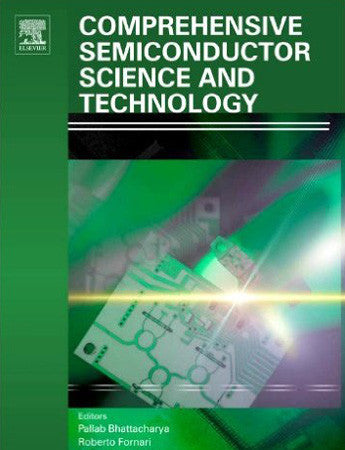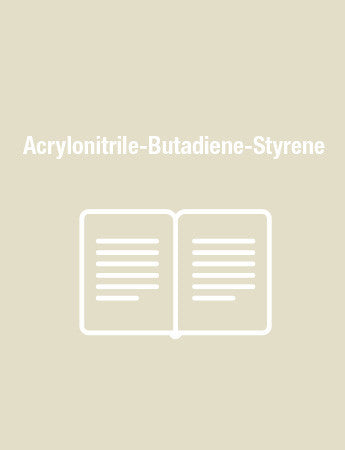Comprehensive Semiconductor Science and Technology, Six-Volume Set
Semiconductors are at the heart of modern living. Almost everything we do, be it work, travel, communication, or entertainment, all depend on some feature of semiconductor technology. Comprehensive Semiconductor Science and Technology captures the breadth of this important field, and presents it in a single source to the large audience who study, make, and exploit semiconductors. Previous attempts at this achievement have been abbreviated, and have omitted important topics. Written and Edited by a truly international team of experts, this work delivers an objective yet cohesive global review of the semiconductor world.
The work is divided into three sections. The first section is concerned with the fundamental physics of semiconductors, showing how the electronic features and the lattice dynamics change drastically when systems vary from bulk to a low-dimensional structure and further to a nanometer size. Throughout this section there is an emphasis on the full understanding of the underlying physics. The second section deals largely with the transformation of the conceptual framework of solid state physics into devices and systems which require the growth of extremely high purity, nearly defect-free bulk and epitaxial materials. The last section is devoted to exploitation of the knowledge described in the previous sections to highlight the spectrum of devices we see all around us.
The work is divided into three sections. The first section is concerned with the fundamental physics of semiconductors, showing how the electronic features and the lattice dynamics change drastically when systems vary from bulk to a low-dimensional structure and further to a nanometer size. Throughout this section there is an emphasis on the full understanding of the underlying physics. The second section deals largely with the transformation of the conceptual framework of solid state physics into devices and systems which require the growth of extremely high purity, nearly defect-free bulk and epitaxial materials. The last section is devoted to exploitation of the knowledge described in the previous sections to highlight the spectrum of devices we see all around us.
Key Features
- Provides a comprehensive global picture of the semiconductor world
- Each of the work's three sections presents a complete description of one aspect of the whole
- Written and Edited by a truly international team of experts
Electrons in semiconductors: Empirical and ab initio theories
Ab initio theories of the structural, electronic and optical properties of semiconductors: bulk crystals to nanostructures
Impurity Bands in Group-IV Semiconductors
Integer Quantum Hall Effect
Composite fermion theory of the fractional quantum Hall effect
Ballistic Transport in GaAs/AlGaAs Heterostructures
Spin-Hall effect: Theoretical
Thermal conduction / thermoelectric power
Electronic structures of Quantum Dots
Control over single electron spins in quantum dots
Atomic structures and electronic properties of semiconductor interfaces
Contact hyperfine interactions in semiconductor heterostructures
Optical properties of semiconductors
Bloch oscillation and ultrafast coherent optical phenomena
Optical properties of Si semiconductor nanocrystals
Excitons and polaritons in semiconductors
Magneto-spectroscopy of semiconductors
Microcavities of semiconductor quantum structures
Semimagnetic semiconductors
Electronic states and properties of carbon crystalline from graphene to carbon nanotubes
Angle-Resolved Photoemission Spectroscopy of Graphen, Graphite, and Related Compounds
Theory of Superconductivity in Graphite Intercalation Compounds
Crystal Growth: an Overview
Molecular Beam Epitaxy: An Overview
Bulk Growth of Crystals of III-V Compound Semiconductors
New Developments in Czochralski Silicon
Growth of CdZnTe Bulk Crystal
Growth of bulk SiC with Low Defect Densities and SiC epitaxy
Growth of Bulk GaN Crystals
Growth of bulk A1N Crystals
Growth of Bulk ZnO
Organometallic Vapor Phase Growth of Group III Nitrides
ZnO epitaxial growth
Nanostructures of metal oxides
Growth of Low Dimensional Semiconductors Structures
Integration of Dissimilar Materials
Ion Implantation in Group III Nitrides
Contacts to Wide Band Gap Semiconductors
Formation of Ultra-shallow Junctions
New High-K Materials for C-MOS Applications
Ferroelectric thin layers
Amorphous chalcogenides
Scanning tunneling microscopy and spectroscopy of semiconductor materials
Study of Semiconductors by High Resolution Microscopy and Aberration Corrected Microscopy
Assessment of semiconductors by Scanning Electron Microscopy Techniques
Characterization of Semiconductors by X-Ray Diffraction and Topography
Electronic Energy Levels in Group III Nitrides
Organic Semiconductors
SiGe/Si Heterojunction Bipolar Transistors and Circuits
Si MOSFETs for VLSI: Scaling Issues and Limits
High Electron Mobility Transistors and Their Applications
High-Frequency and High-Speed InP-Based Heterojunction Bipolar Transistors
Negative Differential Resistance Devices and Circuits
High-Frequency Nitride-Based Field Effect Transistors
Wide band Gap Semiconductor Power Devices
Single Electron Transistors and Their Applications
Molecular Electronics
Electronic and Optoelectronic Properties and Applications of Carbon Nanotubes
Flexible Electronics
MEMS Based Sensors
Avalanche Photodiodes
Optoelectronic Devices and Their Integration By Disordering
Quantum Well Lasers and Their Applications
Quantum Cascade Lasers
Slow Light Devices and Applications
Short Wavelength Light Sources
Nitride-Based LEDs and Superluminescent LEDs
ZnO Based Materials and Devices
MCT Materials and Detectors
Quantum Well Infrared Detectors
Type II Superlattice Detectors
Terahertz Detection Devices
Amorphous and Nanocrystal Silicon Solar Cells
Quantum Dot Lasers: Physics and Applications
High-Performance Quantum Dot Lasers
Quantum Dot Infrared Photodetectors
Photonic Crystal Microcavity Light Sources
Photonic Crystal Waveguides and Filters
Spintronic Devices
Spin-Based Semiconductor Heterostructure Devices
Spin-Polarized Transport and Spintronic Devices
Ab initio theories of the structural, electronic and optical properties of semiconductors: bulk crystals to nanostructures
Impurity Bands in Group-IV Semiconductors
Integer Quantum Hall Effect
Composite fermion theory of the fractional quantum Hall effect
Ballistic Transport in GaAs/AlGaAs Heterostructures
Spin-Hall effect: Theoretical
Thermal conduction / thermoelectric power
Electronic structures of Quantum Dots
Control over single electron spins in quantum dots
Atomic structures and electronic properties of semiconductor interfaces
Contact hyperfine interactions in semiconductor heterostructures
Optical properties of semiconductors
Bloch oscillation and ultrafast coherent optical phenomena
Optical properties of Si semiconductor nanocrystals
Excitons and polaritons in semiconductors
Magneto-spectroscopy of semiconductors
Microcavities of semiconductor quantum structures
Semimagnetic semiconductors
Electronic states and properties of carbon crystalline from graphene to carbon nanotubes
Angle-Resolved Photoemission Spectroscopy of Graphen, Graphite, and Related Compounds
Theory of Superconductivity in Graphite Intercalation Compounds
Crystal Growth: an Overview
Molecular Beam Epitaxy: An Overview
Bulk Growth of Crystals of III-V Compound Semiconductors
New Developments in Czochralski Silicon
Growth of CdZnTe Bulk Crystal
Growth of bulk SiC with Low Defect Densities and SiC epitaxy
Growth of Bulk GaN Crystals
Growth of bulk A1N Crystals
Growth of Bulk ZnO
Organometallic Vapor Phase Growth of Group III Nitrides
ZnO epitaxial growth
Nanostructures of metal oxides
Growth of Low Dimensional Semiconductors Structures
Integration of Dissimilar Materials
Ion Implantation in Group III Nitrides
Contacts to Wide Band Gap Semiconductors
Formation of Ultra-shallow Junctions
New High-K Materials for C-MOS Applications
Ferroelectric thin layers
Amorphous chalcogenides
Scanning tunneling microscopy and spectroscopy of semiconductor materials
Study of Semiconductors by High Resolution Microscopy and Aberration Corrected Microscopy
Assessment of semiconductors by Scanning Electron Microscopy Techniques
Characterization of Semiconductors by X-Ray Diffraction and Topography
Electronic Energy Levels in Group III Nitrides
Organic Semiconductors
SiGe/Si Heterojunction Bipolar Transistors and Circuits
Si MOSFETs for VLSI: Scaling Issues and Limits
High Electron Mobility Transistors and Their Applications
High-Frequency and High-Speed InP-Based Heterojunction Bipolar Transistors
Negative Differential Resistance Devices and Circuits
High-Frequency Nitride-Based Field Effect Transistors
Wide band Gap Semiconductor Power Devices
Single Electron Transistors and Their Applications
Molecular Electronics
Electronic and Optoelectronic Properties and Applications of Carbon Nanotubes
Flexible Electronics
MEMS Based Sensors
Avalanche Photodiodes
Optoelectronic Devices and Their Integration By Disordering
Quantum Well Lasers and Their Applications
Quantum Cascade Lasers
Slow Light Devices and Applications
Short Wavelength Light Sources
Nitride-Based LEDs and Superluminescent LEDs
ZnO Based Materials and Devices
MCT Materials and Detectors
Quantum Well Infrared Detectors
Type II Superlattice Detectors
Terahertz Detection Devices
Amorphous and Nanocrystal Silicon Solar Cells
Quantum Dot Lasers: Physics and Applications
High-Performance Quantum Dot Lasers
Quantum Dot Infrared Photodetectors
Photonic Crystal Microcavity Light Sources
Photonic Crystal Waveguides and Filters
Spintronic Devices
Spin-Based Semiconductor Heterostructure Devices
Spin-Polarized Transport and Spintronic Devices
Pallab Bhattacharya, College of Engineering, University of Michigan, USA.; Roberto Fornari, Institute of Physics, humboldt University, Berlin, Germany. and Hiroshi Kamimura, Department of Applied Physics, Tokyo University of Science, Japan.




